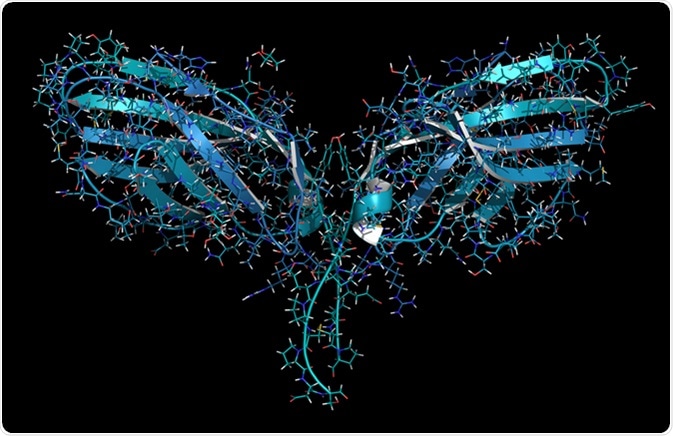Cytotoxic T-lymphocyte-associated protein 4 (CTLA-4), also known as CD152, is a protein receptor and an immunogenic checkpoint that functions as a down-regulator of immune system responses. The gene responsible for encoding this protein is found on chromosome 2 in humans.
CTLA-4 expression occurs on CD4+ and CD8+ T cells almost exclusively, and plays a critical role in their homeostasis. By binding to CD80/86 on antigen-presenting cells (APCs), CTLA-4 is able to effectively block the co-stimulation that would otherwise occur between APCs and T cells.

The parts of this protein consist of a cytoplasmic tail, a transmembrane domain and an extracellular V domain. There has been the characterization of varying isoforms, such as a soluble isoform, which functions as a monomer, and a membrane-bound isoform that exists as a homodimer with a disulfide interconnecting bond. CTLA-4’s intracellular domain has no catalytic activity that is intrinsic to it, but consists of a YVKM motif. This motif is capable of binding PP2A, SHP-2, and PI3K.
While the importance of PI3K binding is unclear, the inhibitory effect of CTLA-4 on T cell responses appears to be mediated via the PP2A and SHP-2 dephosphorylation of the T cell receptor’s (TCR) proximal signaling proteins, such as LAT and CD3.
CTLA-4 and T Cells
Throughout our lives we will face a wide array of pathogens that are unknown to our immune systems. In order to put up a good fight against these biological warriors, our immune system generates its own army in the form of a large T cell receptor repertoire with the ability to recognize a plethora of pathogens. However, sometimes our own army is so strong that our soldiers (i.e. our T cells) may turn on each other and become self-reactive. Hence, here lies the need for controlling these rogue cells.
The thymus plays an important role in attempting to avert the generation of self-reactive T cells, but it is not done 100%, thereby leading to some self-reactive T cells entering the peripheral circulation. Once in the peripheral pool, CTLA-4 steps in to take care of these self-reactive T cells. T-regulatory T cells are the major cell types that express CTLA-4.
In order to work, CTLA-4 causes a directly antagonistic effect on the CD28 co-stimulatory receptor. The importance of both of these receptors have been elucidated in experimental models where mice with genetic CTLA-4 deficits and resultant excessive CD28 stimulation were susceptible to profound autoimmune disease and immune system dysregulation.
CTLA-4 in Drug Therapy
Scientists discovered that CTLA-4 is capable of retaining biological activity in its soluble form. This groundbreaking discovery enabled the engineering of drugs, such as CTLA-4 fusion protein, to treat autoimmune diseases among other medical conditions.
Sources
- www.guidetopharmacology.org/GRAC/ObjectDisplayForward?objectId=2743
- www.sciencedirect.com/…/ctla-4
- http://science.sciencemag.org/content/270/5238/985.long
Further Reading
- All CTLA-4 Content
- CTLA-4 and Cancer
Last Updated: Feb 26, 2019

Written by
Dr. Damien Jonas Wilson
Dr. Damien Jonas Wilson is a medical doctor from St. Martin in the Carribean. He was awarded his Medical Degree (MD) from the University of Zagreb Teaching Hospital. His training in general medicine and surgery compliments his degree in biomolecular engineering (BASc.Eng.) from Utrecht, the Netherlands. During this degree, he completed a dissertation in the field of oncology at the Harvard Medical School/ Massachusetts General Hospital. Dr. Wilson currently works in the UK as a medical practitioner.
Source: Read Full Article
